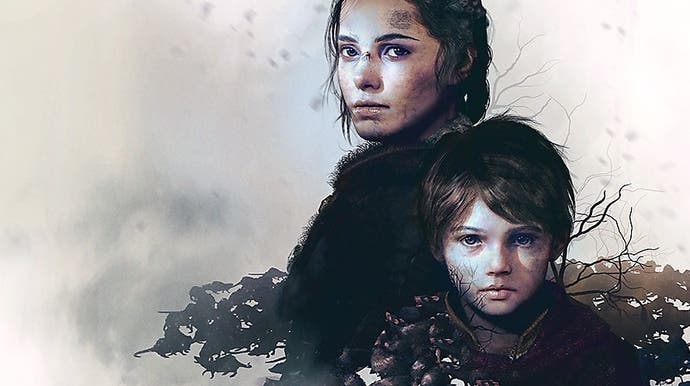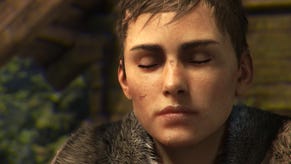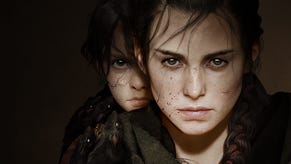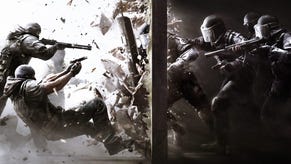A Plague Tale: Innocence review - dull stealth almost spoils a tender and ravishing apocalyptic fable
Heart of the swarm.
Children struggling to right a world wrecked by the old is a popular theme nowadays, within video games and beyond them. Asobo's often-magnificent A Plague Tale: Innocence is one of the more hopeful variations, pitching a small cast of photogenic youngsters against religious zealots and man-eating rats in medieval France. Though let down by an over-reliance on mandatory stealth, which drains a little of the sorcery from some astounding locations, it is a wonderfully dark and tender fairytale whose key draws are its frail but indefatigable protagonists.
As the curtain goes up, noble-born siblings Amicia and Hugo are chased from their family estate by Inquisition soldiers, leaving their parents for dead. The two are relative strangers to one another: the victim of a hereditary sickness, which slowly blackens his veins over the game's 10 hour story, Hugo has spent his whole life locked away in a loft with his mother, a master alchemist. This affliction is the reason for the Inquisition's raid, and you'll spend much of the plot unravelling its arcane origin. The older Amicia - the character you control for most of the game - has grown up in her father's company and is a spirited creature of the outdoors: when we first meet her, she's learning to hunt with her sling. Their home's destruction throws them together for the first time, much as the death of Faye does Atreus and Kratos in God of War, and as in Santa Monica Studio's game, the story marches to the gentle beat of their growing intimacy.
Hugo is often a source of frustration for Amicia, stuffing his hands gleefully into baskets of putrid fruit in deserted villages, and wailing in panic if she tries to explore without him. But his hard-wearing childishness in the face of incessant horror is also her greatest consolation, the thing anchoring her to herself as she does what is necessary for them both to survive. One of the game's loveliest explorations of this takes the unlikely form of a collectible, where Hugo gathers flowers he recognises from their mother's books, inviting his bedraggled and bloodied sister to stoop so that he can plait them into her hair. The flower stays in Amicia's hair for the rest of the chapter, even as you fell pursuing soldiers with your slingshot or shatter their lanterns to expose them to the rats. It's a gesture that says everything about who Amicia and Hugo are to one another, what they've lost and what they've held onto - and tracking down those blossoms quickly became as important to me as mastering the game's slightly wayward mixture of stealth and terrain puzzles.
The ruined lustre of its environments and the sheer adorableness of its characters notwithstanding, A Plague Tale doesn't begin well. It consists, at first, of all the palate-cleansing stealth bits you wish they'd edit out of third-person shooters. The journey across France takes you to a variety of beautifully imagined places - battlefields checkered with trampled ensigns, moonlit cities on loan from Bloodborne - but many of them boil down to pockets of short-sighted soldiers, all trundling around their patrol paths, all talking loudly to each other or themselves. Playing as Amicia, with Hugo holding your hand (you can order him to let go where necessary with the D-pad), you lurk behind upended wagons or in patches of vegetation, waiting for the point in the pattern when every guard has their back to you. You can also lob rocks at crates of armour and smash pots to lure guards away for the genre-required 10 seconds or so of theatrical head-scratching.

Getting caught is typically a recipe for death - Amicia can down unhelmeted opponents with her sling, and break line of sight to reset guard awareness, but unless you have a certain item in your inventory, she's toast the second anybody saunters within swinging distance. It's all rather uninspired next to the melancholy majesty of the setting and the delicacy of the game's incidental dialogue (my tip: pick the French language option - the French-accented English one is fine but a bit Monty Python in places). Worse still are the "big action beats" that conclude some levels - ungainly boss fights in which you circle-strafe while aiming for weakpoints, hold-the-button chase sequences or mercifully brief shooting galleries. The overall feel, for the first few hours, is of a well-wrought and affecting story in thrall to extremely worn-out genre conventions.
Fortunately, there's more to A Plague Tale than sliding between viewcones and counting the beats till an unsympathetic man with a spear looks away. There's the rat horde, first of all, a ravenous tidal entity that explodes through soil and masonry like pressurised oil. The rats will strip the flesh from anything they come across, armour or no armour, but can be kept at bay with light. Accordingly, while dodging Inquisition troops you'll need to attend Thief-style to the play of illumination across each area. You'll use quick-burning branches to force a path through them, the ocean of rodent bodies closing back in behind you as the flame creeps down towards Amicia's fist. Where torches are scarce you'll manipulate parts of the environment, putting your shoulder to a brazier or hauling on a ballista crank to send its burning projectile swinging out towards an object you need.
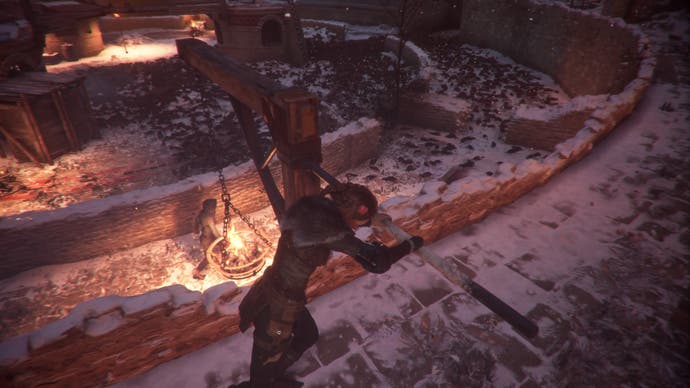
You'll also look for things the rats can scrunch on in place of Amicia and Hugo, from animal carcasses and corpses strung up by your enemies to your enemies themselves. All this changes the feel of the game, from workmanlike sneakery to a gruesome, on-going question of just how awfully you want to treat those hunting for you, with Hugo looking on. I don't think the rat horde concept is quite explored to the full - in the last third, there's a definite sense that the scenario designers have run out of steam - but there are some opulent environment puzzles to chew on, particularly once Amicia and Hugo team up with other characters who have a certain degree of autonomy. The most decadent takes the form of a giant clockwork castle made up of braziers on tracks: to purge the place of scurrying threats, you must work alongside a sour-mouthed thief, moving each brazier one by one to gain access to another.
The other way A Plague Tale grows is in the familiar form of equipment progression. In some respects this represents the game at its most boring, most in hock to genre expectation: workshop benches scattered around chapters let you plug craftable resources into a bevy of iterative improvements, like being able to sling objects without making a noise. More intriguing, though, are the alchemical recipes bestowed on you by some of the people you'll befriend (who have signature abilities of their own you can call on at intervals). These include mixtures that douse torches or kindle embers, and foul-smelling concoctions with which to choke out armoured adversaries, forcing them to remove their helmets. These gadgets are hardly without precedent, and none of the puzzles tethered to them are breathtaking, but they help Plague Tale step away from its clunkier underpinning and make the most of its gorgeous, horrendous locales. There's a marvelous, if slightly rough-hewn additional set of abilities and puzzle considerations towards the end of the game, which expose another side to the rodent plague - I won't spoil them, but suffice to say it's worth the journey.
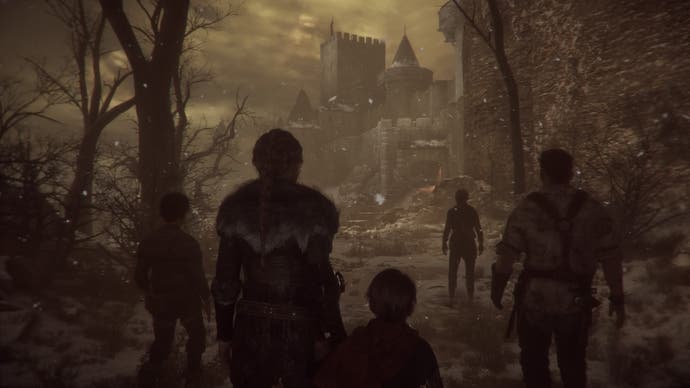
The great shock of Plague Tale is that on some level, it's a Gears of War game. The more obvious comparison is The Last of Us, another poignant, apocalyptic escapade in which an older character guides a more innocent soul whose blood is touched by destiny, but in practice, and for all the absence of chainsaws, it's often Epic's game that comes to mind. It's there in the tanky handling, with characters swivelling ponderously as though secretly many times their own size. It's there in the sense of a historical backdrop (the Sera of Gears is a pastiche of familiar architectural traditions) being softly consumed by the supernatural: the darkness alive with eyeshine, the twisted, bony black rot the rats leave behind them, the alchemical motifs that gradually become the plot's crucible. But above all, it's a question of framing. As in Gears, you spend most chapters wending your way towards some distant landmark, a brooding structure such as a windmill that is teed up for you with a context-sensitive look command, then tugged into and out of view by the intervening geography. It lends each stage of Amicia and Hugo's journey a powerful inexorability, for all the trail-and-error process of bamboozling soldiers - as though you were being drawn through its world by gravity towards a procession of massive objects. It's worth giving into the pull. Just don't forget to look for the flowers.
